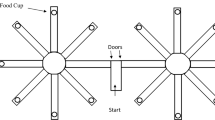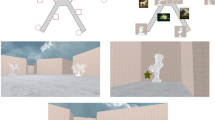Abstract
Rats were exposed to a radial maze containing six black smooth arms and six wire-grid-covered arms and a striped 'exit arm' in experiment 1. The probability of a black or grid arm being baited (5/6 vs 1/6) with sunflower seeds was associated with its proximal cue for some rats (the Relevant Arm Cue group) but not for others (the Irrelevant Arm Cue group). All rats could terminate a trial and receive a highly preferred morsel of apple by entering the exit arm only after having sampled all six seed-baited arms. Relevant Arm Cue rats usually chose some arms from the more densely baited set before choosing an arm from the less densely baited set and made fewer reentries than Irrelevant Arm Cue rats. Although such clustered, higher choice accuracy in the Relevant Arm Cue group corresponds to human clustered, better recall of verbal items from lists hierarchically organized by categories, these rats did not similarly exhaustively retrieve items (arm locations). That is, when required to terminate a trial by entering the 'exit' arm for an apple morsel after having sampled all seed-baited arms, both groups were equally unable to withhold making nonrewarded premature exits. This nonexhaustive foraging search pattern was maintained in the next two experiments in which the radial maze was reduced to three black and three grid arms along with the striped 'exit' arm and in which black and grid arm cues were paired with number of seeds (eight or one) in an arm for Relevant Arm Cue rats. Although Relevant Arm Cue rats displayed perfect clustering by entering all eight-seeded arms before a one-seeded arm, they made more premature exits and reentries into eight-seeded arms in experiment 2 or when forced to enter all eight-seeded arms in experiment 3 than did Irrelevant Arm Cue rats. These foraging tendencies prevent accurate estimations of the amount of information (i.e., arm locations) rats can 'chunk'.




Similar content being viewed by others
References
Ash M, Roberts WA (1992) Central-place foraging by rats on the radial maze: the effect of patch size, food distribution, and travel time. Anim Learn Behav 20:127–134
Atkinson RC, Shiffrin RM (1968) Human memory: a proposed system for its control processes. In: Spence KW, Spence JT (eds) The psychology of learning and motivation, vol 2. Academic Press, New York, pp 89–195
Baddeley AD (1986) Working memory. Oxford University Press, Oxford
Bower GH, Clark MC, Lesgold AM, Winzenz D (1969) Hierarchical retrieval schemes in recall of categorized word lists. J Exp Psychol 103:323–343
Charnov EL (1976) Optimal foraging, the marginal value theorem. Theor Popul Biol 9:129–136
Cohen JS, Burkhart P, Jones N, Innis NK (1990) The effects of an intramaze cue search rule on rats' spatial working memory. Behav Proc 22:73–88
Cohen JS, Mallet PE, O'Malley K (1993) Chunking by proximal arm cues facilitates rats' performance in the radial maze. Learn Motiv 24:413–432
Dallal NL, Meck WH (1990) Hierarchical structures: chunking by food type facilitates spatial memory. J Exp Psychol Anim Behav Proc 16:69–84
Halpern AR (1986) Memory for tune titles after organized or unorganized presentation. Am J Psychol 99:57–70
Hoffman CM, Timberlake W, Leffel J, Gont R (1999) How is radial arm maze behavior in rats related to locomotor search tactics? Anim Learn Behav 27:426–444
Ilersich TJ, Mazmanian DS, Roberts WA (1988) Foraging for covered and uncovered food in the radial maze. Anim Learn Behav 16:388–394
Kamil AC, Yoerg SI, Clements KC (1988) Rules to leave by: patch departure in foraging blue jays. Anim Behav 36:843–853
Kobasigawa A, Middleton DB (1972) Free recall of categorized items by children at three grade levels. Child Dev 43:1067–1072
Krebs JR, McCleery RH (1984) Optimization in behavioral ecology. In: JR Krebs, NB Davies (eds) Behavioral ecology, 2nd edn. Sinauer, Sunderland, Mass. pp 91–121
Macuda T, Roberts WA (1995) Further evidence for hierarchical chunking in rat spatial memory. J Exp Psychol Anim Behav Proc 21:20–32
Miller GA (1956) The magic number seven plus or minus two: some limits to our perspective for processing information. Psychol Rev 63:81–87
Moely BE, Olson FA, Halwes TG, Flavell JH (1969) Production deficiency in young children's clustered recall. Dev Psychol 1:26–34
Olthof A, Macuda T, Roberts WA (1995) Incentive effects on the radial maze and evidence for equivalence sets in rats. Poster session presented at the annual meeting of the Canadian Society for Brain, Behaviour, and Cognitive Science, Halifax, Nova Scotia
Olton DS, Collison C, Werz MA (1977) Spatial memory and the radial arm maze performance of rats. Learn Motiv 8:289–314
Phelps MT, Roberts WA (1989) Central-place foraging by Rattus norvegicus on the radial maze. J Comp Psychol 104:326–338
Roberts WA, Ilerisch TJ (1989) Foraging on the radial maze: the role of travel time, food accessibility, and the predictability of food location. J Exp Psychol Anim Behav Proc 15:274–285
Simon HA (1974) How big is a chunk? Science 1983:482–488
Stephens DW, Krebs JR (1986). Foraging theory. Princeton University Press, Princeton, N.J.
Terrace HS (1991) Chunking during serial learning by a pigeon I. Basic evidence. J Exp Psychol Anim Behav Proc 17:81–93
Terrace HS, Chen S (1991a) Chunking during serial learning by a pigeon II. Integrity of a chunk on a new list. J Exp Psychol Anim Behav Proc 17:94–106
Terrace HS, Chen S (1991b) Chunking during serial learning by a pigeon III. What are the necessary conditions for establishing a chunk? J Exp Psychol Anim Behav Proc 17:107–118
Timberlake W, Leffel J, Hoffman CM (1999) Stimulus control and function of arm and wall travel by rats on a radial arm floor maze. Anim Learn Behav 27:445–460
Acknowledgements
Support for this study came from a grant to J. Cohen from the Natural Sciences and Engineering Council of Canada and from Ontario Work-Study grants to the other authors. Experiment 1 is based on B.A. theses conducted by S. Pardy and H. Solway and experiment 2 is based on a B.Sc. thesis conducted by H. Graham. The authors would like to thank Tanisha Barrington and Sharon Joseph for their assistance in testing the rats. This work complies with all government of Canada (Canadian Council on Animal Care) regulations regarding the use of animals for research.
Author information
Authors and Affiliations
Corresponding author
Rights and permissions
About this article
Cite this article
Cohen, J., Pardy, S., Solway, H. et al. Chunking versus foraging search patterns by rats in the hierarchically baited radial maze. Anim Cogn 6, 93–104 (2003). https://doi.org/10.1007/s10071-003-0168-9
Received:
Revised:
Accepted:
Published:
Issue Date:
DOI: https://doi.org/10.1007/s10071-003-0168-9




